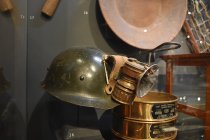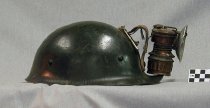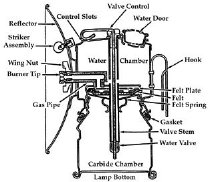Object Catalog Record
Images



Metadata
Title |
Mining helmet with detachable carbine head lamp |
Object # |
2005.2.42.1 A&B |
Object Name |
Helmet, Miner's |
Date |
1925-1930's |
Description |
Miner's helmet with detachable carbine head lamp. Lamp is labeled on the base: Manuf'd by Shanklin MFG Co. Springfield Ill USA. Top of the lamp is labeled: Guy's Dropper Pat. 5-2-12 5-26-14 9-19-16 11-2-20 2-10-25 7-21-25. There is no identification marks on the helmet. The helmet has an inner hat band. On the outside of the hat is a metal backed leather appendage with a metal connection where the carbine lamp hangs from. Attached by a string to the leather appendage is a retractable wire brush. At this time it is unclear what material the helmet is made of. It is potentially leather or some other composite material like canvas and glue. Overall the condition of the helmet is good with only minor scratches and wear areas. The reflector on the lamp is dented and bent on the proper right side of the lamp. A. Helmet B. Lamp |
Provenance |
"Description: An antique carbide lamp is filled with calcium carbide and water in two different chambers. When water is dripped into the calcium carbide chamber, acetylene is produced and the lamp is lit. The flame size is regulated by the amount of water flowing into the chamber." Source: UW card catalog "The advances leading up to the carbide caplamp as we know it started as early as 1897. The first carbide lamps that resemble modern ones came on the scene in 1900. However, they did not have real popularity until the 1920's. Carbide caplamps were primarily used in mines, with other markets supported by farmers, hunters and other outdoors persons. Other larger carbide lamps were used as handlamps for mining foreman, motorcycle headlamps, bicycle lights, military searchlights, and other purposes. For decades the carbide lamp was the only headlamp considered suitable for caving. Its unmatched durability and economy made it the only logical choice for any caver who valued his or her hide. However, the carbide lamp was slowly abandoned for electric lights as they became more reliable and less expensive. The carbide lamp operates because of a chemical reaction between calcium carbide, and water: CaC2 + 2H2O -> Ca(OH)2 + C2H2 + heat The water is stored in a reservoir above the carbide. Set at a rate determined by the user, the water will drip into the carbide chamber. When the water touches the carbide it will produce a hot, damp lime powder and acetylene gas. The gas passes through a filter, through a gas tube, and then through the tip where the gas can be ignited to produce a bright, gentle flame. The light produced by the flame is much different from that of the light produced by a incandescent bulb. Incandescent bulbs produce one very bright spot. Though the spot can be adjusted in many cases, there is a sharp contrast between what is in and out of the spot. Since the eye adjusts to the brightest light it detects, the user will experience a sort of tunnel vision. A carbide lamp will produce a soft diffuse. The light of a carbide will not penetrate as far, but the diffuse will be broader." Source: http://members.tripod.com/carbidecaver/intro.htm - see accession file for full article. |
Dimension Details |
A. Helmet: 5" H x 11.25" L x 9.5" W B. Lamp: 4.375" H x 3" W x 2.875" D Old dimensions: measurements are without the lamp. With the lamp the length is 12 1/4 inches. The lamp measures 4 1/2 x 3 1/8 |
People |
Fosse, Cliff Fosse, Earl |
Search Terms |
Mining Miners Hat Helmet |
Credit line |
Ketchikan Museums, KM 2005.2.42.1 |
